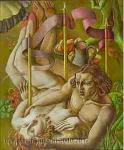Ithell Colquhoun
Ithell Colquhoun
Place: Shillong
Born: 1906
Death: 1988
Biography:
Ithell Colquhoun was a British painter, occultist, and author. Stylistically her artwork was surrealist in content and for a brief time she was part of the organised British surrealist movement.
She was born in Shillong, Eastern Bengal and Assam, British India. From the 1930s to her death, her work was exhibited widely in Britain and Germany.
Margaret Ithell Colquhoun was born in Shillong, Eastern Bengal and Assam, British India. Her parents were Henry Colquhoun, an assistant to the ambassador in Manipur, and his wife Georgia. Colquhoun was educated in Rodwell, near Weymouth, Dorset before attending Cheltenham Ladies' College. There she studied topics such as the cabbala and the occult.
Colquhoun did take some art courses, but she was largely self-taught. Colquhoun studied for a period at the Slade School of Art in London, under Henry Tonks and Randolph Schwabe, before travelling to France in 1931. It was in Paris that she discovered surrealism and was especially influenced by the works of Salvador Dalí. Another influence on Colquhoun was the psychomorphological works of Roberto Matta and Onslow Ford. Her first one-woman exhibition of works was at Cheltenham Art Gallery in 1936. Soon after, she joined the political group, Artists' International Association. She took part in the 1939 exhibition Living Art in England on an independent basis, but that same year she met Breton in Paris and joined the English surrealist group. By 1939, Colquhoun had joined the English Surrealist Group and in June she and Roland Penrose showed their works in a joint exhibition at Mayor Gallery. There they created a scandal by asking a vagrant to sit in the window.
In 1940, E. L. T. Mesens, head of the English Surrealist Group, expelled her from the group for carrying on with occult research. She became a member of the Druidic Order and the Order of the Stella Matutina, both occult groups. After the 1950s, she was regarded as a 'fantamagiste', an unorthodox surrealist who focused on the occult.
Colquhoun lived with Antonio Romanov del Renzio in London during World War II, marrying him in July 1943 and divorcing him a few years later. From 1946, Colquhoun kept a studio near Penzance, Cornwall, while living in London. She finally moved to Cornwall in 1957, where she lived until her death on 11 April 1988.
Michel Remy, Oxford Dictionary of National Biography
Colquhoun's early works included a series of enlarged images of flora, occupying the full canvas and painted almost photographically. By the late 1930s, she had painted two significant pieces; Scylla in 1938, whose joined rocks in the water creates the impression of a "feminine opening" whilst also showing phallic imagery, and Rivières tièdes which shows liquids flowing from a Mediterranean church.
In the 1940s, Colquhoun's works were experiments to explore consciousness and the subconscious. She did this by using recognised methods such as decalcomania, fumage, frottage and collage. Colquhoun went further, developing new techniques such as superautomatism, stillomanay, parsemage, and entoptic graphomania writing about them in her article The mantic stain.
Three works which stand out during the 1940s are The Pine Family, which deals with dismemberment and castration, A Visitation which shows a flat heart shape with multicoloured beams of light and Dreaming Leaps, a homage to Sonia Araquistain. Colquhoun did not define herself as a Surrealist artist, as she only took part in a single Surrealist exhibit. Instead she considered herself "independent"
She has also published poetry (Grimoire of the Entangled Thicket , Ozmazone [1983]) and tales of her travels in Ireland and Cornwall.
Colquhoun gained an early reputation within the British Surrealist movement yet later became better known as an occultist.
In 2012, the scholar Amy Hale noted that Colquhoun "is becoming recognized as one of the most interesting and prolific esoteric thinkers and artists of the twentieth century". Hale noted that through Colquhoun's work "we can see an interplay of themes and movements which characterizes the trajectory of certain British subcultures ranging from Surrealism to the Earth Mysteries movement and also gives us a rare insight into the thoughts and processes of a working magician."
More...
Wikipedia link: Click Here









